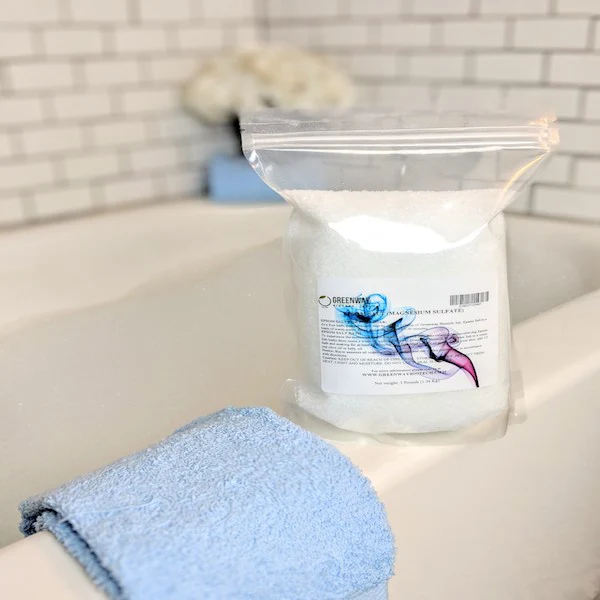8 Useful Epsom Salt Hacks You Need to Know
•Posted on May 27 2016

Despite its name, Epsom salt is not something you put on your fries. It is called salt because of its chemical structure.
Epsom salt, or magnesium sulfate, is an inorganic salt containing magnesium, sulfur, and oxygen.
The product was named after the spring in Epsom, England, where the naturally occurring mineral was discovered in the water.
Long known as a natural remedy for a number of ailments, Epsom salt has numerous health benefits as well as many beauty, household, and gardening-related uses.
Talk about a product that does it all! Read on to learn 8 useful ways to get the most out of your Epsom salt and why you should make it a staple product in your home.
1. Use Epsom Salt as Bath Salts

One of Epsom salt's main uses is as a bath salt. In water, the mineral breaks down into magnesium and sulfate.
When soaking in an Epsom salt bath, your body absorbs these compounds through your skin. This absorption can relax your muscles, relieve pain, and loosen stiff joints or inflammation.
Instructions:- Add 2 cups of Epsom salt to a warm bath.
- Soak in the bath for at least 12 minutes.
- Repeat 3 times a week or as desired.
2. Treat Athlete's Foot and Foot Odor

You don't have to be a sports professional to get athlete's foot: a fungal infection that typically begins between the toes. Soaking your feet in an Epsom salt bath helps relieve the uncomfortable symptoms of athlete’s foot as well as foot odor.
Instructions:- Mix half a cup of Epsom salt in warm water.
- Soak your feet for 10 minutes.
- Pat dry and repeat daily until the condition clears.
3. Treat Toenail Fungus

Epsom salt can improve toenail fungus, a common condition that begins as a white or yellow spot beneath your nail.
Instructions:- Soak your affected toes in hot water mixed with a handful of Epsom salt three times a day.
- Repeat as needed until the infection clears.
4. Relieve Constipation

Studies have revealed that Epsom salt can be used as a laxative to treat constipation. When taken internally, it acts as a detoxifying agent for colon cleansing.
Instructions:- Adults and children 12 years and older: Dissolve 2 to 4 level teaspoons of Epsom salt in 8 ounces of water and drink immediately.
- Children 6 to 11 years old: Dissolve 1 to 2 teaspoons of Epsom salt in 8 ounces of water and drink immediately.
Note: This remedy should not be taken more than once a day. If symptoms continue, consult a physician. Our Epsom salt is not food grade and should not be ingested.
5. Splinter Removal

Epsom salt can make splinter removal easier by reducing swelling around the wound and softening the skin.
Instructions:- Soak the affected area in warm water with 1 cup of Epsom salt for 10 minutes.
- Dry the area.
- Carefully remove the splinter using tweezers.
6. Enhance Beauty Regimens

Soft, smooth skin could be yours with the help of Epsom salt. The mineral works great as an exfoliant to remove dead skin cells.
Instructions:- For Body: In the shower, mix a handful of Epsom salt with a tablespoon of baby oil or olive oil. Rub the mixture all over your wet skin to exfoliate and soften.
- For Face: Mix half a teaspoon of Epsom salt with your regular cleansing cream. Gently massage into your skin, rinse with cold water, and pat dry.
7. Gardening Aid

Magnesium sulfate can be used to fertilize your plants, green up your lawn, remove unwanted pests, and prevent slugs.
When adding magnesium sulfate crystals to your soil, they provide vital nutrients that help prevent yellowing in plants.
Instructions:- Add 1 tablespoon of Epsom salt directly to your soil for every 3 tablespoons of calcium.
- Water thoroughly into your soil.
- Monitor your plants and adjust application frequency as needed.
8. Household Cleaning

Epsom salt can help you clean tiles, remove grout, or even eliminate detergent buildup in your washing machine.
Instructions:- For Tile and Grout: Mix equal parts of liquid dish soap and Epsom salt. Use a sponge or brush to scrub the mixture onto tiles. Rinse well for a streak-free shine.
- For Detergent Buildup: Fill your empty washing machine with hot water. Add a quart of clear vinegar and one cup of Epsom salt. Let the machine agitate for about an hour.
Make Your Life Easier with Epsom Salt
Of all the products you have in your home cabinets, Epsom salt should definitely be one of them considering all that it can do. You can shop our Epsom salt below to get started and have an all-natural product that multitasks as much as you do!
Comments
0 Comments
Leave a Comment